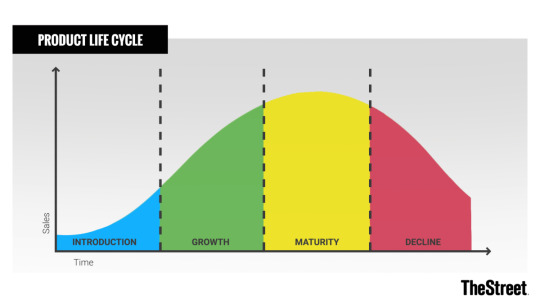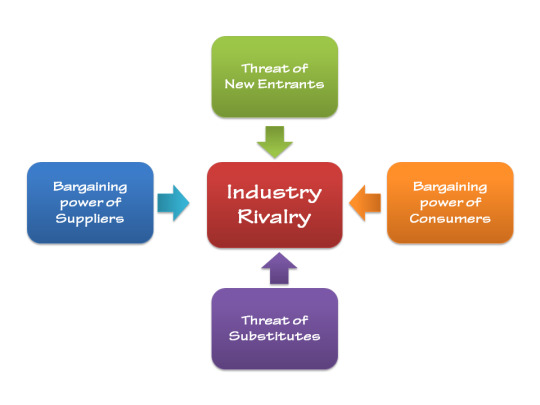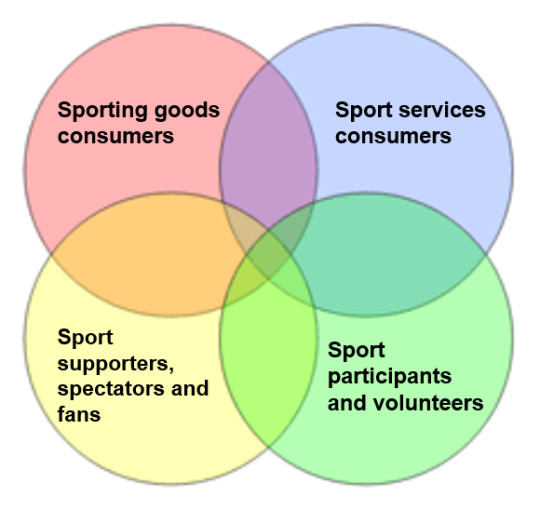Text
Entry 7 - Product Life Cycle
A product that enters the market goes through four stages - introduction, growth, maturity, and decline. This is called the product life cycle.
All products are susceptible to becoming redundant after a period of time due to numerous reasons such as increased competition, market saturation, decreased demand and declining sales (TheStreet)
The way the product is marketed can be influenced by what stage of the life cycle the product is experiencing.

Stage 1: Introduction - Exits developmental stage and enters the market. New products often have slow initial growth. The main goal of marketing strategies during this stage is to build brand and product awareness and attempting to engage with the target market (Avvari, M & Krishnaswamy, K, 2006).
Stage 2: Growth - Brand awareness spreads and the market responds. The benefits of the product become more commonly known by consumers and distributors. This stage often experiences an increased return on investment in comparison to the introduction stage (depending on response from consumers) (Avvari, M & Krishnaswamy, K, 2006).
Suppliers often increase their avenues for distribution in order to keep up with the increased demand.
Marketing strategies and messages often move from product awareness to product preference (Avvari, M & Krishnaswamy, K, 2006).
Stage 3: Maturity - In this stage the sales tend to be at their peak and is the longest stage of the product life cycle. At this stage the ideal situation is that consumers have responded well and competitors have acknowledged the success of the product (Avvari, M & Krishnaswamy, K, 2006).
The supplier must continue to adjust prices and alter/update the actual product in order to appeal to the consumer.
Stage 4: Decline - Product has reached saturation point, resulting in reduced return on investment. The supplier/manufacturer must choose whether to make major modifications to enhance the products relevancy in the market or to move on altogether (Avvari, M & Krishnaswamy, K, 2006).
Another course of action in this stage is just to remain with the status quo and hope that competitors products become expendable in the eyes of consumers. If this happens, this could potentially result in an increase in demand again (Avvari, M & Krishnaswamy, K, 2006). Reducing the price may also extend the products last stage of the life-cycle.
0 notes
Text
Entry 6 - Why is sponsorship leveraging so pivotal to successful associations?
Sponsorship leveraging provides great advantages for sporting organisations and their sponsors. It allows companies to take advantage of the popularity and positive values of sport while also allowing sporting organisations to profit (AdNews, 2000).
Sponsorship leverage creates longstanding partnerships which mutually benefit the sponsor and the organisation that is being sponsored. For example, Hungry Jack’s and the National Basketball Association have recently extended their naming rights partnership until 2023. This is a positive agreement for both the league and the food outlet as the NBL has drawn in record growth in NBL attendances and broadcast audiences over the past five seasons (NBL Media Release).
As a naming rights partner of the league, the Hungry Jack’s logo appears right next to the NBL logo and the season is known as the ‘Hungry Jack’s NBL season’. The logo is also featured on all courts across the league and on all playing jerseys.
Hungry Jack’s would not sponsor the NBL if the league was not promoting them, as that would lead to a lack of public exposure for Hungry Jack’s and therefore little return on investment in the partnership.

Sponsorship leveraging is also valued by consumers. A study conducted in 2001 found that consumers;
1. Had very positive perspectives of sponsorship.
2. Believed sponsorship to be more charitable and good-natured than advertising.
3. Considered sponsorship to be a less intrusive form of communication with an ability to produce “long-term image-related benefits versus simply short-term sales lifts.”
Meenaghan, T, 2001, Sponsorship and advertising: a comparison of consumer perceptions, Psychology and Marketing, Vol.18, No. 22, viewed 1 June 2020
It is important that big businesses understand these 2001 findings. Businesses like banks are typically seen as the bad guys by the general public, however when associated to an organisation with positive reputation, these views can change.

People associate sporting leagues with wellness, health, success. So for banks sponsoring sporting leagues (e.g. NAB sponsoring the AFL), this can help generate a good reputation as people generally believe sponsorship to be good natured and charitable.
0 notes
Text
Entry 5 - Customer Delight
Customer delight is the feeling of a pleasant surprise that goes beyond a customers’ expectations. Satisfaction leads to higher levels of loyalty and can help spread the brand name through word of mouth.
The basics of customer delight include on time delivery, quality performance and customer compliant resolution (Curtis, H, 2016). In one study, some reasons for customer delight included; friendliness of staff, problem solving skills, professionalism of staff and going beyond the call of duty (Torres, E & Kline, S, 2013).
An effective consumer delight experience must be prompt and succinct. Making the customer wait or having the experience corrected will not satisfy or delight the customer.

Image: (Torres, E & Kline, S, 2013)
In order to run a business that provides delightful customer experiences, the company’s employees must be motivated to provide that service. Ways to keep employees satisfied and motivated include; showing respect & concern for employees and their families, providing ongoing training, involve employees in the company and rewarding employees (Curtis, H, 2016).
It was found that company’s which had a higher percentage of satisfied employees, experienced higher customer delight scores (Torres, E & Kline, S. 2013).

Customer delight is also seen in the sports sector due to the uncertainty involved with sport. When your team wins it can give a thrill or a feeling that may have exceeded ones expectations. Teams which experience high amounts of customer delight (i.e. winning games), often experience stronger bonds of loyalty with their supporters. For example; Carlton have won 80 home and away games in the last decade (2010-2019) and currently have just over 64,000 members, whereas the Hawthorn Football Club have won 152 games in the same span and currently have over 77,000 members.
Curtis, H, 2016, Customer Delight, Quality Progress, Vol. 49, No. 1, viewed 9 June 2020, https://search-proquest-com.ezproxy.holmesglen.edu.au/docview/1762043570/fulltextPDF/F39E20A370CD4CEFPQ/1?accountid=132066
Torres, E & Kline, S, 2013, From customer satisfaction to customer delight, International Journal of Contemporary Hospitality Management, Vol. 25, No. 5, viewed 9 June 2020, https://search-proquest-com.ezproxy.holmesglen.edu.au/docview/1398041893/fulltextPDF/4545DF7594794E3APQ/1?accountid=132066
0 notes
Text
Entry 4 - What are the elements in a SWOT analysis?
Many sporting organisations and businesses use a strategic planning guide to help them create and evaluate their businesses environment and/or competition (Verboncu, I & Condruache, A, 2016) This is called a SWOT or situational analysis and is often used to guide business/marketing decisions that with help achieve goals, or improve on areas of weakness (Verboncu, I & Condruache, A, 2016).
SWOT examines the strengths, weaknesses, opportunities and threats in the environment.
Strengths: Resources, skills / advantages over competitors
Weaknesses: Limitations, lack of certain resources and capabilities in comparison to competitors
Opportunities: Situations/circumstances that can be taken advantage of
Threats: Unfavourable circumstances

Discussion question 1: What are the four main components of a SWOT analysis?
Strengths - Weaknesses - Opportunities - Threats
Discussion question 2: Why do you think it is necessary and important to conduct a SWOT analysis on a place such as the MCG?
It’s necessary to conduct a SWOT analysis on the MCG as many strengths, weaknesses, opportunities and threats can arise from holding an event at the MCG. It is important to evaluate whether the strengths outweigh the weaknesses from a business standpoint when holding an event, i.e profits vs losses. It is also essential that when planning an event at the MCG that opportunities are maximised and threats are minimised where possible.
Holding an event at the MCG:
Strengths: Large crowd capacity
Weaknesses: Long lines / busy / expensive tickets / people don’t have the means to get to venue
Opportunity: Make profits other than the actual event, e.g. At a football match - selling footy records and having many places to buy food/drink
Match on TV = advertising revenue
Threats: Another event on at the same time, (football match) people may watch the event on TV instead, coronavirus (2020)
0 notes
Text
Entry 3 - What are the different kinds of market segmentation options?
Market segmentation is used to figure out how an organisation should divide its customers or into smaller groups based on characteristics such as age, gender, background, residence, interests, personality traits, income or behaviour (Maricic, B & Dordevic, A, 2015).
To meet the specific needs of consumers, organisations must alter its product and marketing strategies based on the chosen segment or segments in a market (Smith & Stewart 2015).
Firstly, segmentation can be used for process: Research, define segments.
Secondly, segmentation can be used to define goals: Increase, improve and sell the product.

Consumers can be grouped in a multitude of ways, in market segmentation, the five main ways are through; geographic, demographic, psychographic, behavioural and socio-economic status.

Geographic: Consumers can be divided based on their residence. Segmenting via geographical location may include suburbs, cities, states and countries as well as local climate and resources (Smith & Stewart 2015).
Psychographic: Consumers personality, values, opinions, attitudes, interests, and lifestyles (Smith & Stewart 2015).
Behavioural: The actions and thought processes of individuals, based on themselves or their environment. Behaviours in a consumer context include product usage, brand loyalty, technology (Smith & Stewart 2015).
Demographic: This type of segmentation is the most common in marketing. Demographic includes whole societies or groups defined by gender, age, education, nationality, religion, ethnicity etc. (Smith & Stewart 2015).
Socio-economic: Aspects of a consumer’s social or economic situation such as income, education level and occupation (Smith & Stewart 2015).
Maricic, B & Dordevic, A, 2015, Strategic Marketing Segmentation, Marketing, Vol. 46, No.4, viewed 2 June 2020, http://scindeks-clanci.ceon.rs/data/pdf/0354-3471/2015/0354-34711504243M.pdf
Smith, A & Stewart, B 2015, Introduction to Sports Marketing, 2nd edn, Routledge, Oxford, UK
0 notes
Text
Entry 2 - What are the elements of Porter’s 5-forces analysis?
Porter’s Five Forces is a tool that companies often use to evaluate the competitiveness of the business environment and for identifying the potential profits of business strategies.
Harvard Business School professor, Michael Porter, is the man behind Porter’s Five Forces. His main goal was to design a tool that helped industries assess potential profits and consumer interest.

Competitive rivalry is the evaluated by the number of competitors and how strong those competitors are. It is important for businesses to know how many rival companies they have and how their quality stacks up in comparison to yours (CFI Education Inc). Intense rivalry may involve lowering prices to attract customers and formulating persuading marketing campaigns. Suppliers and buyers may be able to move over to competitors if it suits them better.
Bargaining power of buyers refers to the influence that buyers have on suppliers to reduce prices or alter their product. When switching costs are low, customers have the power to either no longer purchase the product, or switch to a more suitable brand (The Strategic CFO, 2013). However, if there is lack of available options to switch to, or the switching costs are high, bargaining power of buyers is low.
Bargaining power of suppliers is the very similar of the bargaining power of buyers and it means “the pressure that suppliers can put on companies by raising their prices, lowering their quality, or reducing the availability of their products” (CFI Education Inc). Suppliers may do this to demand better deals for themselves and gain an upper hand on industry competitors. The more suppliers there is to choose from, the easier it is for companies to change suppliers, whereas if there are fewer suppliers, they have a higher bargaining power.
Threat of new entrants: A industry that appears to be profitable will attract more competitors who are also looking to achieve profits. New entrants pose as a threat to existing companies in in an industry as they could potentially take away their consumers. If entry barriers are low for new entrants, then this is could saturate the market and negatively affect firms already competing in that market (The Strategic CFO). The threat of new entrants into an industry can force companies to keep lower down or spend more to retain customers.
Threat of substitution: A substitute product is something offered from another industry that provides similar benefits to the consumer as the product produced by the firms within the industry (The Strategic CFO, 2013). Substitutes are a threat as they can be cheaper or higher performing. For example, Pepsi and Coca Cola are not substitutes, they are competitors in the same industry. However, tea could be classified as a substitute because it has potential to affects soft drink industry if consumers choose to drink tea instead (The Strategic CFO, 2013).
0 notes
Text
Entry 1 - Who are the different types of sports consumers and why might you differentiate them?
A sports consumer is an individual who purchases sporting goods, uses sport services, participates or volunteers in sport and/or follows sport as a spectator or fan (Smith, A & Stewart, B, 2015).
Sport consumers exhibit an array of values, attitudes and behaviours (Samra, B & Wos, A, 2014). Consumers vary in the level of passion and investment they contribute towards their teams, associations and communities (Stewart, B, Smith, A & Nicholson, M, 2003).

Sporting goods consumers – Sports goods consumers purchase items that have a sport-related aspect or purpose such as equipment, apparel, books, magazines, nutritional and health supplements, games, merchandise, memorabilia and licensed products. This may either be a direct purchase of sporting goods such as buying a tennis racquet or indirectly, such as a sporting game on console (Smith, A & Stewart, B, 2015).
Sport services consumers – Sport services consumers utilise a sport related service or experience. Sport related services include education, gambling, specialised coaching, medical services and recreational and health activities such as those offered by pools, gyms and leisure centres. Sport services do not include viewing sport or participating in sport (Smith, A & Stewart, B, 2015).
Sport participants and volunteers – Sport participants and volunteers are involved in sport either as participants or in voluntary organisational and support roles. This includes all participants in school, recreational and organised club sport (Smith, A & Stewart, B, 2015).
Sport supporters, spectators and fans – Sport supporters view sport on TV, internet, radio or at the game. They use sport products & services in ways that other consumers do not. More engaged sport supporters may post about sport online or are involved in fantasy sport leagues. Fanatical sport consumers may act in a way that does not align with normal social expectations (Smith, A & Stewart, B, 2015).

Of course, sports consumers can fall into all four of these categories. Sport consumer motivations are multi-variable and complex. It is easier to categorise four types of sport consumption rather than place individuals in a single category of sport consumption (because they often overlap into multiple categories).

So, the reason we want to differentiate between these different consumers is because it helps marketers identify the best way to engage the consumers they want to target. From a marketer’s perspective, it is essential to evaluate consumer behaviours and their motivations. Certain consumer behaviours may be influenced by age, demographic, social and cultural groupings (Stewart, B, Smith, A & Nicholson, M, 2003).
By differentiating sports consumers and their habits, sport marketers can perfect marketing initiatives, improve sport products, monitor price sensitivities, adjust promotional campaigns and tailor the sport experience to suit the needs of each customer segment (Stewart, B, Smith, A & Nicholson, M, 2003).
0 notes